NATO Summit Agenda

The NATO Summit brought together leaders from across the alliance to discuss pressing security challenges and chart the course for the future of the organization. Key topics on the agenda included the war in Ukraine, the rise of China, and the evolving threat landscape.
The NATO summit brought together leaders from across the globe to discuss pressing security concerns. Among those in attendance was Senator Marco Rubio , a vocal advocate for a strong NATO alliance. Rubio’s presence underscored the importance of the summit, as NATO continues to play a crucial role in maintaining global security and stability.
War in Ukraine
The war in Ukraine dominated the summit agenda, with leaders reaffirming their commitment to supporting Ukraine’s defense against Russian aggression. They agreed to provide additional military aid, including heavy weapons and air defense systems, and to strengthen NATO’s presence in Eastern Europe.
The summit also saw the adoption of a new Strategic Concept, which Artikeld NATO’s priorities for the next decade. The concept emphasized the need to deter and defend against Russia, while also addressing other threats such as terrorism and cyberattacks.
Rise of China, Nato summit
The summit also addressed the growing challenge posed by China. Leaders expressed concern over China’s military modernization and its increasingly assertive behavior in the Indo-Pacific region.
They agreed to strengthen NATO’s cooperation with partners in the region, including Japan, South Korea, and Australia. They also called on China to engage in dialogue and to uphold the rules-based international order.
Evolving Threat Landscape
In addition to the war in Ukraine and the rise of China, leaders also discussed other evolving threats to NATO’s security, including terrorism, cyberattacks, and climate change.
The NATO summit, a gathering of leaders from across the globe, has sparked discussions about the importance of truth and integrity in international relations. As nations grapple with complex geopolitical issues, it is crucial to distinguish between genuine dialogue and the manipulative tactics employed by “congenital liars” (link to article on congenital liars).
The summit serves as a reminder that trust and transparency are essential for building a more stable and peaceful world.
They agreed to strengthen NATO’s capabilities in these areas, including by investing in new technologies and developing new strategies to address these threats.
Significance of Decisions
The decisions made at the NATO Summit are significant for the future of the alliance. They represent a clear commitment to deterring and defending against Russia, while also addressing other threats to NATO’s security.
The new Strategic Concept provides a roadmap for NATO’s future, outlining the alliance’s priorities and the steps it will take to meet the challenges of the 21st century.
NATO’s Response to Russia: Nato Summit

Since Russia’s illegal annexation of Crimea in 2014 and its ongoing aggression in eastern Ukraine, NATO has taken a series of measures to deter and defend against further Russian aggression. These measures have included increasing the alliance’s military presence in Eastern Europe, providing military assistance to Ukraine, and imposing economic sanctions on Russia.
Military Measures
NATO has significantly increased its military presence in Eastern Europe since 2014. The alliance has deployed four multinational battlegroups to Estonia, Latvia, Lithuania, and Poland, and has also increased the number of troops stationed in Romania and Bulgaria. NATO has also conducted a series of military exercises in Eastern Europe, designed to demonstrate the alliance’s readiness to defend its members.
Political Measures
In addition to military measures, NATO has also taken a number of political measures in response to Russia’s aggression. The alliance has suspended all practical cooperation with Russia, and has imposed economic sanctions on the country. NATO has also increased its diplomatic engagement with Ukraine, and has provided the country with political and financial support.
Effectiveness of NATO’s Measures
NATO’s measures have had a significant impact on Russia. The alliance’s military presence in Eastern Europe has deterred Russia from further aggression, and its economic sanctions have damaged the Russian economy. NATO’s political measures have also isolated Russia internationally, and have made it more difficult for the country to pursue its aggressive policies.
However, NATO’s measures have also had some negative consequences. The alliance’s military presence in Eastern Europe has increased tensions with Russia, and its economic sanctions have harmed the economies of some NATO members. NATO’s political measures have also made it more difficult for the alliance to engage with Russia on other issues, such as arms control and nuclear non-proliferation.
NATO’s Future Challenges
NATO faces several significant challenges in the coming years. These include the ongoing threat from Russia, the rise of China, and the growing threat of terrorism. NATO must adapt to these new challenges while continuing to uphold its core mission of defending its members.
Russia
Russia remains NATO’s most significant security threat. Russia has been modernizing its military and has been increasingly assertive in recent years. Russia has also been accused of interfering in the internal affairs of other countries, including NATO members. NATO must continue to deter Russia and be prepared to respond to any aggression.
China
China is a rising power that is increasingly challenging the United States and its allies. China is investing heavily in its military and is developing new technologies that could give it an edge in a future conflict. NATO must take into account China’s rise when planning for the future.
Terrorism
Terrorism remains a major threat to NATO members. Terrorist groups are constantly evolving and adapting their tactics. NATO must continue to work with its partners to combat terrorism and protect its members.
The Future of NATO
NATO must continue to adapt to the changing security environment. The alliance must be prepared to face new threats and challenges. NATO must also continue to strengthen its partnerships with other countries and organizations. NATO is a vital alliance that has helped to keep Europe safe for over 70 years. The alliance must continue to adapt and evolve to meet the challenges of the 21st century.